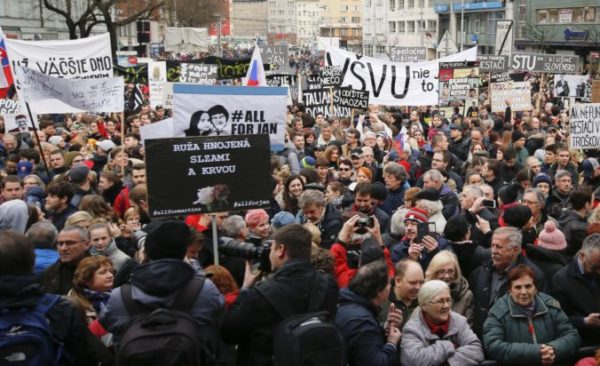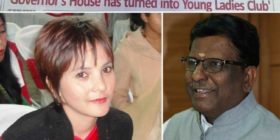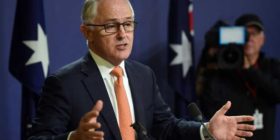During his decade as Slovakia’s prime minister, Robert Fico flashed all the moves of the strongman autocrats now so in vogue the world over.
He snarled at journalists, answering tough questions with epithets such as “hyena” and “prostitute.” He scapegoated Muslim refugees and a Jewish financier for his country’s troubles. His party cozied up to Slovak oligarchs, Russian apparatchiks and Italian mafia kingpins, while he lived large in a luxurious hilltop apartment with sweeping views of the Danube.
Then something extraordinary happened: An investigative reporter hot on the trail of Fico’s finances was killed, and tens of thousands of people in the once apathetic nation cared enough to take to the streets. Rather than be intimidated by the killing, journalists dug deeper. Grass-roots opposition movements sprang from nowhere. Constitutional checks kicked in.
Under pressure from all sides, Fico resigned.
The peaceful uprising that has transformed politics in this landlocked nation of 5 million is a striking counterpoint to global trends that seem to favor leaders willing to bend rules, norms and institutions to their will. From China to Russia to Turkey — and, President Trump’s critics would say, even in the United States — political currents have swung toward consolidated power, nationalist messaging and intolerance for competing voices.
In few regions has that been more apparent than in Eastern Europe. Countries that shook off the shackles of communism three decades ago increasingly resemble the one-party states of old. Hungary and Poland, in particular, have taken a turn toward illiberalism and autocracy.
Slovaks who see themselves as part of the democratic West once feared that their tiny nation, independent only since its 1993 cleavage from the Czech Republic, could follow. The protests of the past month were, at least in part, about ensuring it did not.
“We didn’t want to end up like Hungary,” Seliga said.
By his admission, Seliga was living a “boring” life as recently as a month ago, a typical graduate student ensconced in his research.
Like many here, he was profoundly shaken by the slaying of investigative journalist Jan Kuciak, whose body was discovered Feb. 25 alongside that of his fiancee, Martina Kusnirova. Both were 27, and both had been shot to death at close range at their home outside the capital.
No one has been charged with the killings. Suspicions immediately centered on Kuciak’s work as the likely motive.
Kuciak had been investigating a tangled web of business dealings among government officials, local tycoons and the Italian mafia. Much of his reporting focused on Fico, who had hired as his personal assistant a former topless model. The model was linked to an Italian businessman connected in court documents with organized crime.
Reports of alleged corruption had been a recurring feature of the 53-year-old Fico’s reign, to little effect. But the killing touched a nerve. Solemn vigils of thousands of mourners, many weeping in the streets, gave way to angry protests, with tens of thousands calling on Fico to step down.
Seliga put graduate school on hold and became an organizer, creating from scratch with a handful of other young political neophytes a nationwide movement galvanized by outrage. “We’re the same age that Jan and Martina were,” he said. “Jan was just doing his job, trying to show how the governing party really works. And he was killed for it.”
At Aktuality.sk, the news site where Kuciak worked, there was horror, shock and fear after their colleague’s death. Then there was resolve.
“It was unimaginable,” said Peter Bardy, the site’s top editor, describing the moment he learned that his reporter was dead. “We’re a member of the European Union. We thought this couldn’t happen.”
The newsroom sits at the modern edge of Bratislava’s medieval core, with the staff of 27 — 26, after Kuciak’s slaying — arrayed in cubicles across an open-plan office. A billboard outside depicts Kuciak and Kusnirova in silhouette, along with the words “You cannot kill the truth.” Armed security guards stand watch at the door.
Inside, Kuciak’s cubicle is just as he left it, his desk strewn with coffee-stained mugs, charging cables and a chart depicting connections among top government officials and unsavory figures from the underworld.
Kuciak, Bardy said, had a savantlike ability to sniff out patterns where others might see only an indecipherable stream of data.
“I’d tell people that it was just like ‘The Matrix,’ ” Bardy said.
Now Bardy has a team of 10 reporters picking up where Kuciak left off. They are working in collaboration with rival Slovak outlets, several of which posthumously published his last piece — a bombshell about embezzled E.U. funds, the mob and senior Slovak officials.
Even then, Bardy said, the prime minister was ridiculing the slain journalist’s work. “He was laughing at it,” said Bardy, who met with Fico days after the killing. “He said: ‘They killed him for that? No way.’ ”
In public, too, Fico was refusing to acknowledge the public’s genuine anger and disgust. He insinuated the protests had been secretly organized by the 87-year-old Hungarian American investor George Soros and warned that the demonstrations could turn violent — words organizers took as a threat.
Slovakia’s president, Andrej Kiska, watched Fico’s response with growing alarm, said Rado Bato, a senior presidential adviser.
“It was out of touch with reality, with the sentiment in society, with the whole atmosphere,” said Bato, whose boss is a longtime rival of Fico’s but is not associated with the political opposition or any other party. “Nobody believed there was a conspiracy involving George Soros. Those tactics don’t work in a situation where the trigger is the murder of two young people.”
The president has limited power in Slovakia. As the symbolic leader of the nation, he commands moral authority — and he used it to force Fico’s hand with a call for new elections or a change in personnel at the very top.
“Sometimes enough is enough,” Bato said.
Fico, whose grip on power was never as absolute as that of other strongman leaders such as Hungary’s Viktor Orban, stepped down on March 15. He did so with a smile, telling Kiska: “Don’t worry. I’m not going anywhere.”
Fico remains head of the ruling party, and the new prime minister is his former deputy. Many are skeptical that the new leader will depart from the course set by Fico, who first became prime minister in 2006 and has led the country for 10 of the past 12 years.
“I don’t believe that this government is capable of producing change,” said Grigorij Meseznikov, president of the Bratislava-based Institute for Public Affairs.
Meseznikov — who described the past month’s protests as being larger than the Velvet Revolution demonstrations of 1989 that brought the then-communist government of Czechoslovakia crashing down — said the effect should not be underestimated.
The power dynamics in Slovakia, he said, have clearly shifted. An illustration came March 22, when the new interior minister chose on his first day of work to subject himself to a media-sponsored two-hour public grilling. It was a humbling display from a government whose hallmark had been opacity and arrogance in the face of criticism.
“It’s your right to ask me tough questions,” the minister, Tomas Drucker, acknowledged as he absorbed one withering query after the next from a senior investigative journalist and the leader of an anti-corruption watchdog.
The next day, too, there was an air of change in Bratislava. Although organizers called off what had become customary Friday demonstrations, a silent vigil attracted thousands of people — many of them bearing homemade signs.
“Our passivity is killing us,” read one.
“I’m angry,” read another, held aloft by a young blond girl.
Zuzana Hruzova, a 35-year-old yoga teacher, said she had never paid attention to politics before the past month.
“But the murders of these young people really touched me,” she said, a pink scarf pulled tight to ward off the March chill. “If there’s something dirty in our government, it should be sent out.”
Hruzova said she did not even bother to vote the last time she had the chance.
Asked recently by a clipboard-wielding activist to add her name to a petition seeking new elections, she did not hesitate. She signed.
Mirek Toda contributed to this report.






Leave a reply